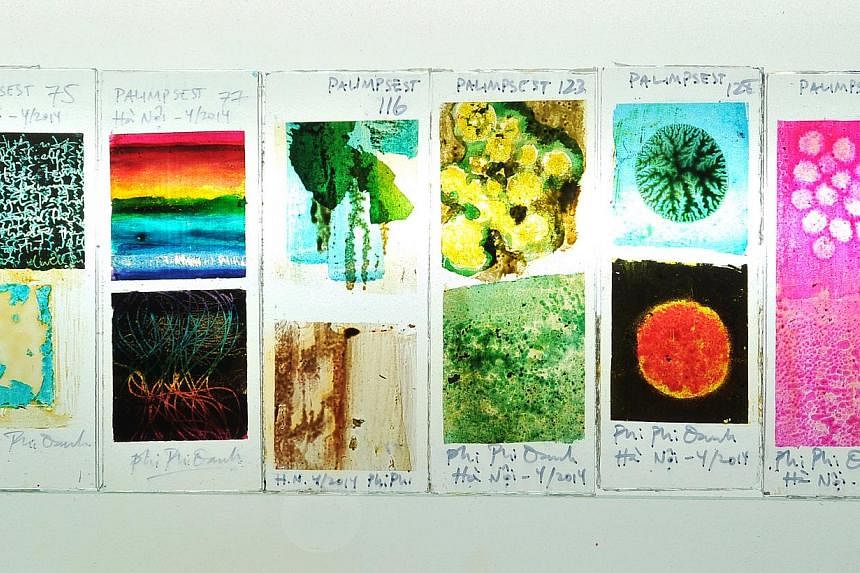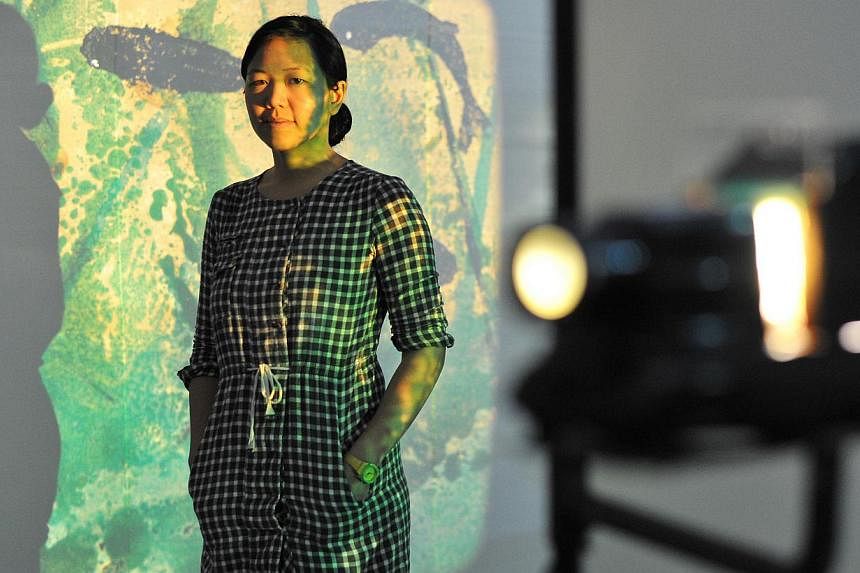Art lovers who slunk through the lustrous lacquer passageway which VietnameseAmerican artist Phi Phi Oanh showed here a few months ago will likely remember their intimate encounter with a traditional art form writ large.
Her work, Specula (2009), a glowing arched structure, turned two-dimensional lacquer painting into an experiential space. It occupied the entire chapel of the Singapore Art Museum during the Singapore Biennale, which ran from last October to February.
For her encore, the United States-born artist based in Vietnam has returned with her first solo show here and a new body of work which goes from large to all-embracing.
The exhibition at Fost Gallery in Gillman Barracks is a cavernous light installation. Eighty-one lacquer images ranging from organic shapes to silhouettes of major monuments in the world are painted on glass slides, shining through nine slide projectors onto walls and translucent silk screens. The result: a phantasmal space.
The work, Palimpsest, flows from Specula and stems from Oanh's enduring curiosity about the potential for traditional Vietnamese lacquer art to be presented in fresh ways and imbued with new meaning.
Lacquer, obtained from plant sap, is typically applied in layers to surfaces before it is carved or sanded down to create pictorial compositions.
Oanh, however, has sought to move away from conventional depictions and styles of lacquer painting since the start of her artistic practice 10 years ago.
The 37-year-old artist says: "With Specula, lacquer was used to create space. In Palimpsest, lacquer painting shows how we see things today, often through a lens or screen, for example, a smartphone screen, and it turns what we see into something bigger or smaller than it actually is."
Peer through a microscope and what is invisible to the naked eye becomes magnified and discernible. Look into a telescope and colossal planets faraway appear as specks before one's eyes. On the screen of a smartphone, objects evanesce into immaterial digital pixels.
She adds: "So much of what we see today is through machines. It used to be that seeing is believing, but now, if it is not verified by the Internet, it is not true; if it is not found on the Internet, it doesn't exist."
It is all the more apt then, that the changing way by which people perceive reality is expressed with a form of art which is both "ancient and new".
Explaining this paradox of Vietnamese lacquer painting, she points out that the history of lacquer stretches centuries back, often as a decorative overlay for objects, but it emerged as a form of painting in Vietnam only at the start of the 20th century. For her, this opens up opportunities to experiment with ways of presenting the art form while still adhering to the time-honoured Vietnamese technique of working with lacquer, layering and polishing the resin.
For Palimpsest, her approach has been to dematerialise lacquer painting, to separate lacquer from its physical substrate, usually wood. This quest led her to paint on glass slides and turn the images into ethereal projections.
The method emphasises the luminous quality of lacquer and, by using a projector for photographic slides to cast the lacquer images, the work uncovers a realm between lacquer and photography.
Coming up with a new language for Vietnamese lacquer art, however, is not without growing pains.
Painting on the miniature slides, for example, was an experience akin to "pulling teeth" at the start, she says. "There is no precedent for doing this and the slides are so small, I had to find the right tools."
But she adds, her voice swelling: "I am finding a vocabulary for a new way of making lacquer art."


